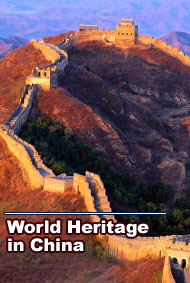
|
|
|
Imperial Palace of the Ming and Qing Dynasties (Beijing)
Brief Introduction The Forbidden City, located in the center of Beijing, used to be the imperial palace of the Ming and Qing dynasties. Its construction started in 1406, and was completed in 1420. The rectangular palace covers an area of some 720,000 sq. km -- 961 m in length and 760 m in width. It has a total of 9999.5 room spaces (an area enclosed by four poles). In 1924, the imperial family of the Qing Dynasty was removed from the Forbidden City, and in 1925 the Palace Museum was established here. The Forbidden City has four entrance gates: the main Meridian Gate (Wumen) to the south, the Eastern Flower Gate (Donghuamen), the Western Flower Gate (Xihuamen), and the Gate of Divine Prowess (Shenwumen) to the South. The palace grounds are divided into two parts: the Front Palace (Qianchao) to the south and the Inner Palace (Neiting) to the north. The Front Palace consists chiefly of three magnificent and solemn halls ---- the Hall of Supreme Harmony (Taihedian), the Hall of Central Harmony (Zhonghedian), and the Hall of Preserving Harmony (Baohedian). The Inner Palace includes the Palace of Heavenly Purity (Qianqinggong), the Hall of Prosperity (Jiaotaidian) and the Palace of Earthly Tranquility (Kunninggong). Cultural Heritage An Unparalleled Architectural Masterpiece The Forbidden City is China's largest and most intact ancient building complex. It is laid out symmetrically along a north-south axial line. The well-designed palace appears magnificent, solemn and harmonious, representing the long cultural tradition of China and its outstanding architectural accomplishments five centuries ago. It is a truly superb masterpiece in every sense. A Treasure House of Rare and Valuable Art Works The Palace Museum in the Forbidden City has the country's largest collection of ancient art works, some of which are invaluable national treasures. Art works in the museum's collection total 1,052,653, including paintings, pottery, bronze wares, inscribed wares, toys, clocks and court documents. Architecture The Forbidden City is encompassed by a wall 10 m high, and surrounded by a moat 5.2 m wide. The palace has four entrance gates: the main Meridian Gate (Wumen) to the south, the Eastern Flower Gate (Donghuamen), the Western Flower Gate (Xihuamen), and the Gate of Divine Prowess (Shenwumen) to the South. One has to pass through seven gates to arrive at the Palace of Heavenly Purity (Qianqinggong), the emperors' living quarters. These seven gates, starting from the very southern gate of the imperial city, are: Zhengyangmen, Damingmen, Tiananmen, Duanmen, Wumen, Taihemen and Qianqingmen, which symbolize the celestial Plough. The palace grounds are divided into two parts: the Front Palace (Qianchao) to the south and the Inner Palace (Neiting) to the north. The Front Palace consists chiefly of three halls ---- the Hall of Supreme Harmony (Taihedian), the Hall of Central Harmony (Zhonghedian) and the Hall of Preserving Harmony (Baohedian). Here, important ceremonies, such as the accession of a new emperor to the throne and the emperor's birthday and wedding, were held. There are two groups of buildings on each side of the three great halls: the Hall of Literary Glory (Wenhuadian) and the Imperial Library (Wenyuange) on the east and the Hall of Military Prowess (Wuyingdian) on the west. The Inner Palace mainly includes the Palace of Heavenly Purity (Qianqinggong), the Hall of Prosperity (Jiaotaidian) and the Palace of Earthly Tranquility (Kunninggong), where emperors and empresses lived. Behind them is the Imperial Garden. On each side of the inner three great halls are six eastern palaces and six western palaces, respectively, which were used as residences for concubines. The six eastern palaces are Jingrengong, Yanxigong, Chengqiangong, Yonghegong, Zhongcuigong and Jingyanggong. The six western palaces are Yongshougong, Taijidian, Yunkungong, Changchungong, Chuxiugong and Chengfugong. There are some Buddhist sanctuaries to the east of the six eastern palaces and to the west of the six western palaces. Besides the inner and outer courts, there are also two major building compounds: the Outer Eastern Road (Waidonglu) and the Outer Western Road (Waixilu). To the south of the Outer Eastern Road are the Southern Three Halls (Nansansuo), residences for princes. To the north are the Hall of Supreme Royalty (Huangjidian) and the Hall of Peaceful Longevity (Ningshougong). Further northward are the Hall of Mental Cultivation (Yangxidian), the Hall of Happiness and Longevity (Leshoutang), the Hall of Harmony (Yihexuan) and the Garden of the Hall of Peaceful Longevity. To the south of the Outer Western Road is the Hall of Peaceful Benignity (Cininggong), and to its north are some Buddhist sanctuaries. Art Treasures The Palace Museum is China's largest museum. It has in its collection about one million valuable art works, most of which were in the possession of the imperial families of the Ming and Qing dynasties. These art treasures include paintings, pottery, bronze wares, gold and silver wares, embroidery, sculptures, inscribed wares, jade wares, lacquer wares and lacquer enamel wares. In addition, there are also court articles, including jewels, accessories, clocks, medicines, furniture and furnishings. It is a unique, superb building complex, integrating the outstanding achievements of ancient Chinese architecture. In 1961, the Forbidden City was included in the List of Key Historical Monuments under State Protection. And in 1987, it was put on the World Heritage List of UNESCO. |